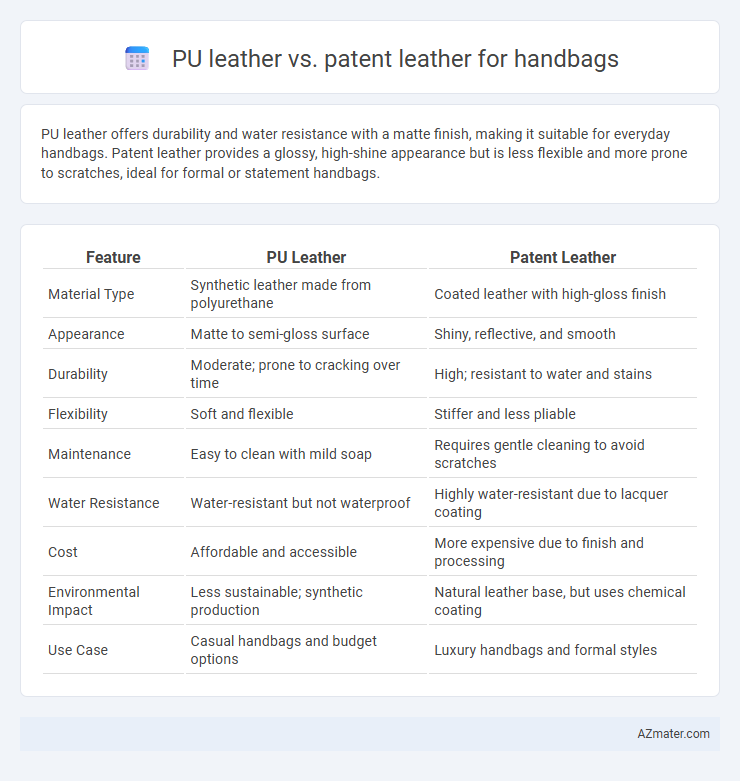PU leather offers durability and water resistance with a matte finish, making it suitable for everyday handbags. Patent leather provides a glossy, high-shine appearance but is less flexible and more prone to scratches, ideal for formal or statement handbags.
Table of Comparison
| Feature | PU Leather | Patent Leather |
|---|---|---|
| Material Type | Synthetic leather made from polyurethane | Coated leather with high-gloss finish |
| Appearance | Matte to semi-gloss surface | Shiny, reflective, and smooth |
| Durability | Moderate; prone to cracking over time | High; resistant to water and stains |
| Flexibility | Soft and flexible | Stiffer and less pliable |
| Maintenance | Easy to clean with mild soap | Requires gentle cleaning to avoid scratches |
| Water Resistance | Water-resistant but not waterproof | Highly water-resistant due to lacquer coating |
| Cost | Affordable and accessible | More expensive due to finish and processing |
| Environmental Impact | Less sustainable; synthetic production | Natural leather base, but uses chemical coating |
| Use Case | Casual handbags and budget options | Luxury handbags and formal styles |
Introduction to PU Leather and Patent Leather
PU leather, a synthetic material made from polyurethane, offers a durable and affordable alternative to genuine leather, often used in handbag manufacturing for its water resistance and ease of maintenance. Patent leather is characterized by its high-gloss finish achieved through a coating process, providing a sleek, shiny appearance favored in formal and luxury handbags. Both materials differ in texture, durability, and maintenance requirements, influencing handbag design and consumer preferences.
Material Composition: PU Leather vs Patent Leather
PU leather is a synthetic material made from a split leather backing coated with a polyurethane layer, offering a flexible and durable finish resembling genuine leather. Patent leather, on the other hand, features a natural leather base treated with a high-gloss coating, typically lacquer or polyurethane, resulting in a shiny, smooth surface. The key difference lies in PU leather's fully synthetic coating versus patent leather's natural leather core combined with a glossy finish, affecting texture, durability, and appearance in handbags.
Appearance and Finish: Shine, Texture, and Color
PU leather offers a matte to semi-gloss finish with a consistent grain pattern, providing a smooth and soft texture that mimics genuine leather, making it versatile for handbags with a subtle, natural look. Patent leather features a high-gloss, mirror-like shine achieved through a lacquered coating, giving handbags a sleek, polished appearance with a firm and slightly rigid texture. Color saturation in PU leather tends to be rich and uniform but less vibrant than patent leather, which exhibits bold, reflective hues that enhance the handbag's visual impact.
Durability and Longevity Comparison
PU leather offers moderate durability with resistance to cracking and peeling, making it a cost-effective choice for everyday handbags. Patent leather, coated with a glossy finish, provides superior water resistance and enhanced scratch protection, resulting in longer-lasting appearance and structural integrity. While patent leather generally outperforms PU leather in longevity, both materials require proper care to maintain their durability.
Weight and Flexibility Factors
PU leather offers a lightweight and flexible alternative to patent leather, making it ideal for handbags that prioritize comfort and ease of use. Patent leather tends to be heavier and stiffer due to its glossy, coated finish, which can limit flexibility but provides a structured and polished appearance. When choosing between the two, consider PU leather for everyday wearability and patent leather for a more formal, durable handbag style.
Maintenance and Cleaning Requirements
PU leather handbags require gentle cleaning with a damp cloth and mild soap to prevent surface damage and maintain flexibility, while avoiding harsh chemicals that can cause cracking. Patent leather handbags demand regular wiping with a soft cloth and a specialized patent leather cleaner to preserve their glossy finish and prevent discoloration or stickiness. Both materials benefit from proper storage away from direct sunlight and heat to extend their lifespan and appearance.
Environmental Impact and Sustainability
PU leather offers a more sustainable alternative to patent leather, as it is made from synthetic materials that require less water and energy during production, reducing its carbon footprint. Patent leather involves a plastic coating process that relies heavily on non-renewable resources and generates more pollution. Choosing PU leather for handbags supports reduced environmental impact through lower resource consumption and improved recyclability.
Price Point and Affordability
PU leather handbags typically offer a more affordable price point compared to patent leather, making them a popular choice for budget-conscious consumers seeking stylish options. Patent leather handbags, made from coated genuine leather, tend to be more expensive due to higher production costs and luxurious finish. The durability and glossy appearance of patent leather justify its premium pricing, while PU leather provides a cost-effective alternative with decent durability and a variety of design options.
Suitability for Fashion Trends and Design
PU leather offers versatility with its matte, textured finish, making it ideal for contemporary and minimalist handbag designs that align with current fashion trends. Patent leather provides a glossy, high-shine surface favored for bold, statement handbags, often seen in luxury and evening fashion collections. Both materials cater to different design aesthetics, with PU leather suitable for casual and everyday styles, while patent leather excels in creating eye-catching, trend-driven pieces.
Final Verdict: Which Leather is Best for Handbags?
PU leather offers affordability, durability, and water resistance, making it an excellent choice for everyday handbags that require maintenance ease and versatility. Patent leather provides a glossy, high-fashion finish with excellent scratch resistance but demands careful handling to avoid cracking over time. For handbags balancing style and practicality, PU leather is best suited for regular use, while patent leather excels in chic, statement pieces for special occasions.

Infographic: PU leather vs Patent leather for Handbag
 azmater.com
azmater.com